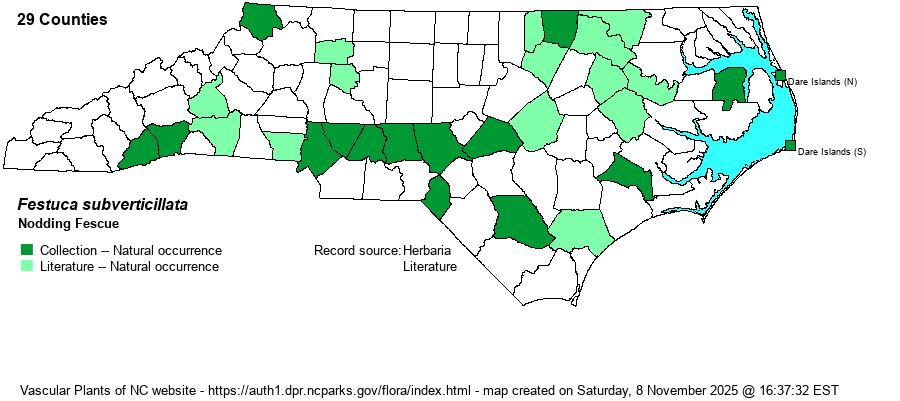| Author | (Persoon) Alexeev | |
| Distribution | Mountains and Piedmont; Coastal Plain occurrences are along brownwater rivers or in other rich soil situations.
Que. to Man., south to FL and TX. | |
| Abundance | Frequent to common, except uncommon along a few Coastal Plain brownwater rivers, but rare away from them. This is clearly an S5 species. | |
| Habitat | Rich mesic to moist hardwood and hardwood-pine forests, often on slopes near brownwater rivers. Outer Coastal Plain habitats include calcareous forests (Jones County) and maritime forests (Dare County). | |
| Phenology | Flowering and fruiting May-July. | |
| Identification | These plants grow up to 3 feet tall, with a sparse (few branches), very open inflorescence with 2-5 spikelets loosely clustered at the branch ends. The branches, and sometimes the whole inflorescence, arch outward and downward. It grows in some of the same habitats as F. paradoxa, but differs in the fewer-flowered, looser inflorescence. Its field gestalt is similar to that of Poa cuspidata, which may grow with it but differs in lemmas with obvious dorsal keel or low ridge (vs. no keel) and spikelets with hairs at the base (vs. no hairs). | |
| Taxonomic Comments | Long known as F. obtusa.
Bromus, Festuca, and Poa all can look quite similar to beginners (and even veterans!), because they all have multi-flowered spikelets. Generally speaking, Bromus has much the largest spikelets, and most Poa have a tuft of wispy hairs at the base of each floret (lacking in the other genera). Bromus and Festuca have obvious awns on the florets (absent in Poa). With field experience and careful use of keys, one can eventually handle these genera.
Our annual species of Festuca are by some authors placed in the genus Vulpia; they have a single stamen (vs. perennial and with 3 stamens). | |
| Other Common Name(s) | None | |
| State Rank | [S5] | |
| Global Rank | G5 | |
| State Status | | |
| US Status | | |
| USACE-agcp | FACU link |
| USACE-emp | FACU link |

